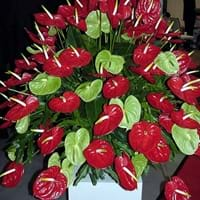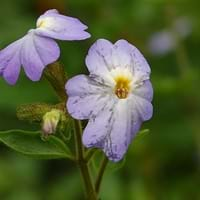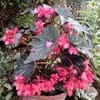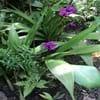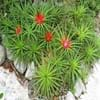Life Span
Annual and Perennial
Perennial
Type
Tender Perennial
Tender Perennial
Origin
Central America, South America
South America
Types
not available
Not Available
Habitat
Humid climates, Tropical Forests
Subtropical climates, Tropical regions
USDA Hardiness Zone
10-11
10-15
Sunset Zone
H2
H1, H2, 17, 23, 24
Habit
Clump-Forming
Cushion/Mound-forming
Flower Color
Yellow, Red, Orange Red
White, Blue Violet
Flower Color Modifier
Bicolor
Bicolor
Fruit Color
Not Available
Not Available
Leaf Color in Spring
Green, Light Green
Light Green
Leaf Color in Summer
Green, Light Green
Light Green
Leaf Color in Fall
Green, Light Green
Light Green
Leaf Color in Winter
Green, Light Green
Light Green
Leaf Shape
Oblong
broad, flat
Plant Season
Spring, Summer, Fall, Winter
Summer, Fall
Sunlight
Partial Sun, Partial shade
Partial Sun, Partial shade
The pH of Soil
Neutral
Acidic, Neutral, Alkaline
Soil Drainage
Well drained
Well drained
Bloom Time
Indeterminate
Early Summer, Summer, Late Summer, Early Fall
Tolerances
Drought
Drought
Where to Plant?
Container, Ground, Pot
Container, Ground, Pot
How to Plant?
Seedlings, Vegetative
Seedlings, Stem Cutting
Plant Maintenance
Medium
Medium
Watering Requirements
Keep ground moist, Keep the Soil well drained, Requires regular watering
Average Water Needs, Never Over-water
In Summer
Lots of watering
Lots of watering
In Spring
Moderate
Moderate
In Winter
Average Water
Average Water
Soil pH
Neutral
Acidic, Neutral, Alkaline
Soil Drainage Capacity
Well drained
Well drained
Sun Exposure
Partial Sun, Partial shade
Partial Sun, Partial shade
Pruning
Remove damaged leaves, Remove dead branches, Remove dead leaves
Remove damaged leaves, Remove dead branches, Remove dead leaves
Fertilizers
All-Purpose Liquid Fertilizer
All-Purpose Liquid Fertilizer
Pests and Diseases
Mealy bugs, Mites, Nematodes, Scale
Aphids, Leaf spot, Red blotch, Whiteflies
Plant Tolerance
Drought
Drought
Flower Petal Number
Single
Single
Foliage Texture
Coarse
Medium
Foliage Sheen
Glossy
Matte
Attracts
Flies, Flying insects, Insects, Not Available
Aphids
Allergy
Toxic
Not Available
Aesthetic Uses
along a porch, deck or patio, Borders, Decorating walls, Hanging Basket, Used for decorating walls, fences, gates, hedges, etc.
Beautification, Hanging Basket, Showy Purposes
Beauty Benefits
Not Available
Not Available
Environmental Uses
Air purification
Air purification
Medicinal Uses
Boils, Rheumatism
Not Available
Part of Plant Used
Flowers, Shoots
Flowers, Leaves
Other Uses
Used as Ornamental plant, Used for its medicinal properties, Used for Landscaping
Used as Ornamental plant
Used As Indoor Plant
Sometimes
Yes
Used As Outdoor Plant
Yes
Yes
Garden Design
Bedding Plant, Container, Cutflower, Foundation, Houseplant, Tropical
Bedding Plant, Container, Hanging Basket, Houseplant, Rock Garden / Wall
Botanical Name
ANTHURIUM andraeanum
BROWALLIA speciosa
Common Name
Flamingo Lily, Oil Cloth Flower, Oilcloth Flower, Tail Flower, Tailflower
Amethyst Flower
In Hindi
tail flower
नीलम फूल
In German
Schwanz Blume
Amethyst Blume
In French
Anthurium andraeanum
Améthyste Fleur
In Spanish
tail flower
amatista flor
In Greek
Tail flower
Αμέθυστος λουλούδι
In Portuguese
Tailflower
flor Amethyst
In Polish
Anturium Andrego
Amethyst Flower
In Latin
Tail flower
Amethyst Flower
Phylum
Tracheophyta
Magnoliophyta
Class
Liliopsida
Magnoliopsida
Order
Solanales
Solanales
Family
Araceae
Solanaceae
Genus
Anthocercis
Browallia
Clade
Angiosperms, Asterids, Eudicots
Angiosperms, Asterids, Eudicots
Tribe
Anthurieae
Not Available
Subfamily
Not Available, Pothoideae
Not Available
Number of Species
Not Available
Season and Care of Tail Flower and Amethyst Flower
Season and care of Tail Flower and Amethyst Flower is important to know. While considering everything about Tail Flower and Amethyst Flower Care, growing season is an essential factor. Tail Flower season is Spring, Summer, Fall and Winter and Amethyst Flower season is Spring, Summer, Fall and Winter. The type of soil for Tail Flower is Loam and for Amethyst Flower is Loam while the PH of soil for Tail Flower is Neutral and for Amethyst Flower is Acidic, Neutral, Alkaline.
Tail Flower and Amethyst Flower Physical Information
Tail Flower and Amethyst Flower physical information is very important for comparison. Tail Flower height is 30.00 cm and width 30.00 cm whereas Amethyst Flower height is 30.00 cm and width 20.30 cm. The color specification of Tail Flower and Amethyst Flower are as follows:
Tail Flower flower color: Yellow, Red and Orange Red
Tail Flower leaf color: Green and Light Green
Amethyst Flower flower color: White and Blue Violet
- Amethyst Flower leaf color: Light Green
Care of Tail Flower and Amethyst Flower
Care of Tail Flower and Amethyst Flower include pruning, fertilizers, watering etc. Tail Flower pruning is done Remove damaged leaves, Remove dead branches and Remove dead leaves and Amethyst Flower pruning is done Remove damaged leaves, Remove dead branches and Remove dead leaves. In summer Tail Flower needs Lots of watering and in winter, it needs Average Water. Whereas, in summer Amethyst Flower needs Lots of watering and in winter, it needs Average Water.
